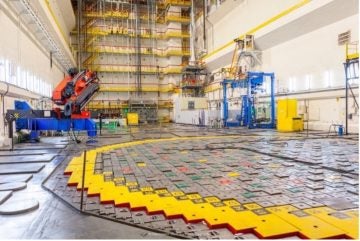
Removal of nuclear fuel has been completed from the RBMK-1000 reactor at Leningrad NPP unit 2, which was shut down in 2020 in preparation for decommissioning. All fuel assemblies that had not reached half of the design burnup levels were transferred to the RBMKs at Leningrad 3&4 for further afterburning.
Deputy Chief Engineer for Nuclear Safety & Reliability at the Leningrad NPP, Arkady Sokolovsky explained that the project began in 2019 immediately after the shutdown the RBMK at Leningrad unit 1.
Currently Leningrad NPP has four units in operation – units 3&4 with Soviet RBMK-1000 reactors, as well units 5&6 with new VVER-1200 units (also known as Leningrad-II 1&2). Units 5&6 replaced units 1&2, RBMKs which were decommissioned in 2018 and 2020. New VVER-1200 units (7&8) will replace units 3&4. They are scheduled to be put into commercial operation in 2030 and 2032.
“All work was, and is, being carried out in strict accordance with the requirements of current standards and regulations in the nuclear energy industry,” said Sokolovsky. The possibility and validity of the Leningrad nuclear scientists’ proposals for reburning nuclear fuel from shutdown reactors was confirmed by scientific and technical support institutes – the NA Dollezhal Scientific Research & Design Institute of Power Engineering (Nikiet), the National Research Centre Kurchatov Institute and the All-Russian Research Institute for the Operation of Nuclear Power Plants (VNIIAES). “And now we can say that the indicators, which were forecast, have been confirmed. Moreover, they will be exceeded – the afterburning of the nuclear fuel will save 1,010 fresh fuel assemblies.”
During the implementation of the project for the additional use of nuclear fuel from units 1&2, transportation of approximately 870 fuel assemblies from each of the closed reactors to the operating RBMK units was organised. Standard technological equipment wherever possible. In total, about 100 specialists, engineers and workers were involved in the work.
The final completion of the project is planned for December 2024, when the last fuel assemblies removed from the closed units will be loaded into the operating reactors at units 3&4. It is worth noting that the experience of the Leningrad NPP in post-combustion of nuclear fuel is currently also being used at the Kursk NPP, where similar work has already begun – Kursk 1 was closed in 2021 and unit 2 in January 2024. Kursk 3&4 remain in operation. Smolensk NPP – Russia’s only other NPP with operating RBMKs – will use the same system as the units are closed.
In order the ensure the safest and most efficient afterburning technology: a transport and technological system for handling nuclear fuel was developed; the necessary design documentation was issued; the safety of the entire technological sequence of work was justified; new equipment was manufactured, installed and tested: operational documentation was developed: and personnel were trained.






